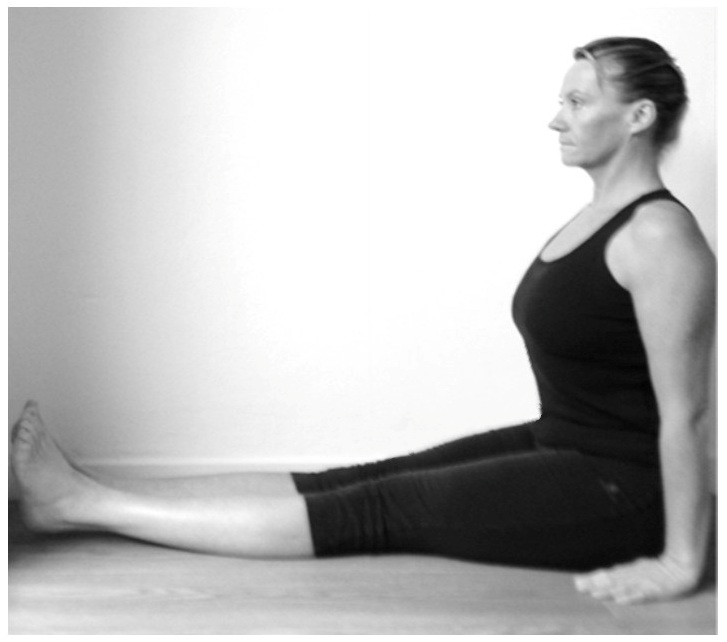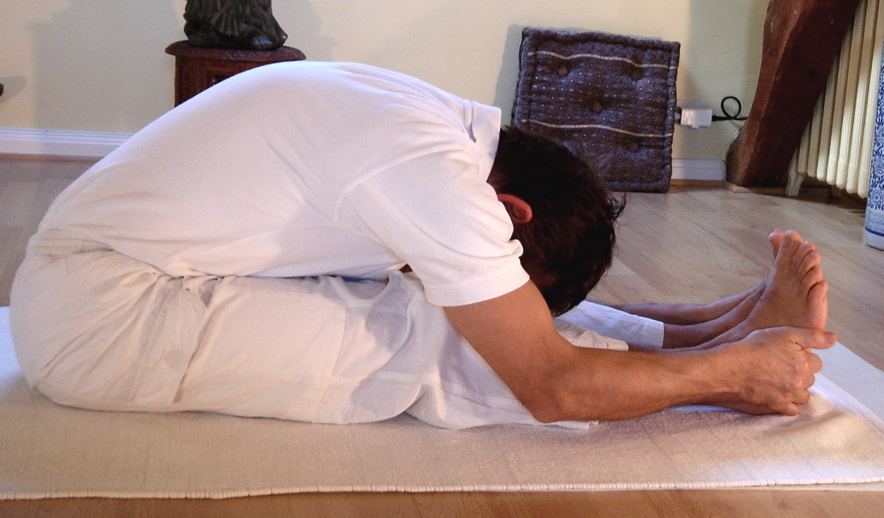 |
Joseph RENGER, CC BY-SA 3.0, via Wikimedia Commons |
Among these, the twisting postures hold a special place, revered for their powerful detoxifying and invigorating qualities. At the heart of this category lies Ardha Matsyendrasana, a beautifully complex and deeply beneficial pose often referred to as the Half Lord of the Fishes Pose.
Named after the great sage Matsyendranath, one of the founders of Hatha Yoga, this asana is far more than a simple spinal twist; it is a holistic practice that systematically works on the entire body, from the tips of the toes to the crown of the head.
 |
Jemasty, CC BY-SA 3.0, via Wikimedia Commons Dandasana (Staff Pose) |
To truly understand the essence of this posture, one must first learn the art of its execution. The journey into Ardha Matsyendrasana begins from a comfortable seated position, with the legs extended straight out in front of you.
With a straight and elongated spine, you are invited to draw your awareness inward, preparing the body and mind for the forthcoming twist. The first step involves bending the right knee and placing the right foot on the outside of the left thigh, ensuring the sole of the foot is flat on the floor. This placement is crucial, as it sets the stage for the deep abdominal compression that is central to the pose’s benefits. Next, the left knee is bent, and the left foot is tucked in towards the right hip, with the heel resting as close to the buttock as is comfortable. It is important to maintain a sense of grounding through both sitting bones, keeping them firmly connected to the earth.
 |
Joseph RENGER, CC BY-SA 3.0, via Wikimedia Commons |
How to Do
With the legs positioned, the upper body is prepared for the twist. Taking a deep inhalation, the yogi is encouraged to lengthen the spine, drawing the crown of the head towards the sky.
This creates space between the vertebrae, protecting the spine and allowing for a more profound and safe twist.
As you exhale, the torso begins its graceful rotation to the right. The left arm is brought across the body, hooking the elbow over the outside of the right knee. This leverage is key to deepening the twist.
Simultaneously, the right hand is placed on the floor behind the back, a few inches away from the tailbone. This backhand acts as a supporting pillar, helping to maintain a tall, straight spine throughout the pose.
The final stage of the posture involves the head and neck, which follow the direction of the twist, allowing the gaze to drift gently over the right shoulder. With each subsequent inhalation, the spine lengthens, and with each exhalation, the practitioner can mindfully deepen the twist, always listening to the body and never forcing the movement.
After holding the pose for a recommended duration of several deep breaths, the practitioner gently unwinds, releasing the twist and returning to the starting position before repeating the entire sequence on the opposite side. This symmetrical practice ensures that the benefits are evenly distributed throughout the body.
For those who find the full expression of the pose challenging, a modification can be made by keeping the bottom leg (in this case, the left leg) extended straight, which eases the intensity of the twist.
 |
Joseph RENGER, CC BY-SA 3.0, via Wikimedia Commons |
Health Benefits
The methodical execution of Ardha Matsyendrasana leads to an impressive array of health benefits that are both immediate and cumulative. One of the most prominent advantages of this posture is its profound effect on spinal health.
The twisting motion lubricates the joints between the vertebrae, increasing the spine's flexibility and range of motion. In a world where sedentary lifestyles are common, this twist counteracts the stiffness that can accumulate from prolonged sitting and poor posture.
The gentle pressure and release on the spinal nerves help to rejuvenate the entire nervous system, improving the flow of neural impulses and promoting a sense of vitality. This enhanced spinal mobility is foundational to overall health, as a supple and strong spine is integral to a healthy and pain-free body.
Beyond the spine, Ardha Matsyendrasana is a potent tool for improving digestive health. The powerful abdominal compression and massage that occur during the twist work directly on the internal organs, including the liver, kidneys, pancreas, and spleen. This action is akin to wringing out a sponge; it compresses the organs, pushing out stagnant blood and toxins.
When the twist is released, a fresh surge of oxygenated blood rushes into these organs, revitalizing them and boosting their function. This stimulation is particularly beneficial for the digestive system, as it can improve sluggish digestion, alleviate constipation, and stimulate the metabolic process.
The pose can also help in regulating the secretion of digestive juices, which is a key factor in efficient nutrient absorption and the breakdown of food.
 |
Joseph RENGER, CC BY-SA 3.0, via Wikimedia Commons |
Furthermore, the Half Lord of the Fishes Pose has a remarkable calming effect on the nervous system.
The deliberate and controlled twisting motion, synchronized with the breath, stimulates the parasympathetic nervous system, which is responsible for the body’s “rest and digest” response.
In doing so, it helps to quiet the mind, reduce levels of stress and anxiety, and release accumulated mental fatigue. This tranquilizing effect can lead to improved mental clarity, heightened focus, and a more balanced emotional state.
For individuals who grapple with the constant demands of modern life, incorporating this twist into a regular practice can provide a much-needed mental respite, helping to restore a sense of inner peace and resilience. The focused engagement with the present moment required to hold the pose is a form of moving meditation that grounds the practitioner and pulls them away from the cycle of anxious thoughts.
The benefits of Ardha Matsyendrasana extend to the entire circulatory system. The twisting action improves blood flow not only to the abdominal organs but also to the reproductive organs, and it helps to relieve congestion in these areas. The twist facilitates the circulation of blood and lymph, which is vital for a healthy immune system and for the efficient removal of waste products from the body's tissues.
This improved circulation can contribute to a feeling of lightness and energy, as the body’s cells are better supplied with oxygen and nutrients. Additionally, the pose offers a deep stretch to the shoulders and neck, common areas where people hold tension.
As the gaze turns over the shoulder, the neck and trapezius muscles are gently stretched, releasing stiffness and improving mobility in the upper body. The pose also strengthens the core muscles, which are actively engaged to maintain an erect and stable spine. A strong core is the foundation for good posture and is essential for preventing back pain and injuries.
In conclusion, Ardha Matsyendrasana is a testament to the holistic wisdom of yoga. It is a posture that weaves together physical alignment, mental focus, and energetic cleansing into a single, powerful practice. Its benefits are far-reaching and interconnected, addressing the body's need for flexibility, the digestive system's need for stimulation, and the mind's need for calm.
From revitalizing the spine and improving digestion to reducing stress and strengthening the core, the Half Lord of the Fishes Pose offers a comprehensive prescription for general health and well-being. As we consciously move and breathe through this elegant twist, we not only pay homage to an ancient tradition but also actively participate in the restoration and rejuvenation of our own body and mind, proving that a single, intentional posture can be a gateway to profound and lasting health.


